Management Accounting Techniques Report: Decision Making & Performance
VerifiedAdded on 2020/07/22
|8
|2561
|68
Report
AI Summary
This report delves into management accounting, focusing on its role in organizations, particularly within Alpha Ltd. It explores essential cost accounting terms, classifications, and techniques, emphasizing their importance in profit and revenue evaluation. The report outlines various decision-making techniques, such as decision matrix, T-chart, and SWOT analysis, to facilitate informed business decisions. Furthermore, it identifies and explains appropriate budgeting techniques like variance analysis and zero-based budgeting for effective planning and control. Finally, the report examines performance management information and measurement systems, highlighting their significance in assessing organizational performance. The content covers financial strategies, cost monitoring, and profitability maintenance, offering a comprehensive overview of management accounting practices.
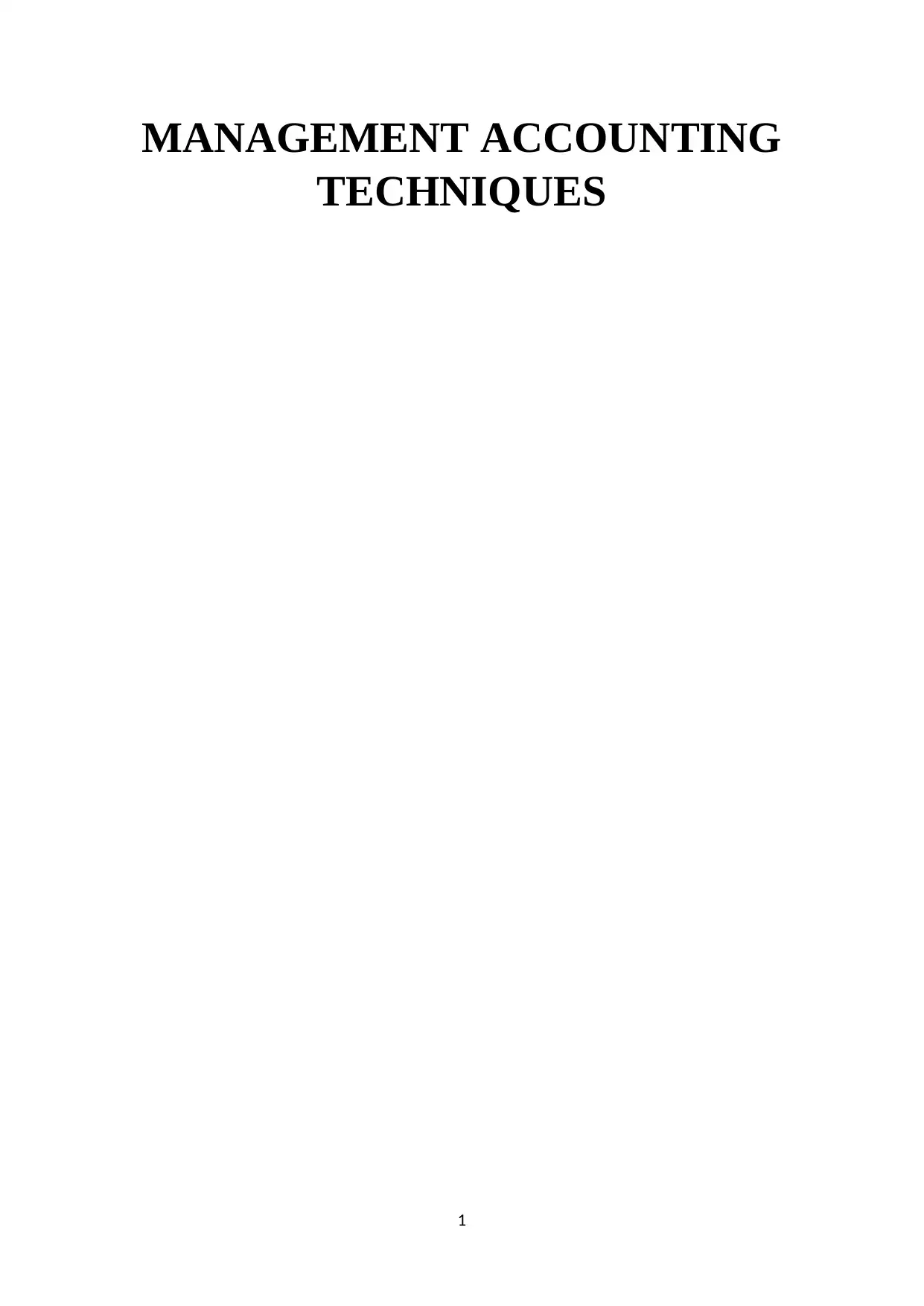
MANAGEMENT ACCOUNTING
TECHNIQUES
1
TECHNIQUES
1
Paraphrase This Document
Need a fresh take? Get an instant paraphrase of this document with our AI Paraphraser
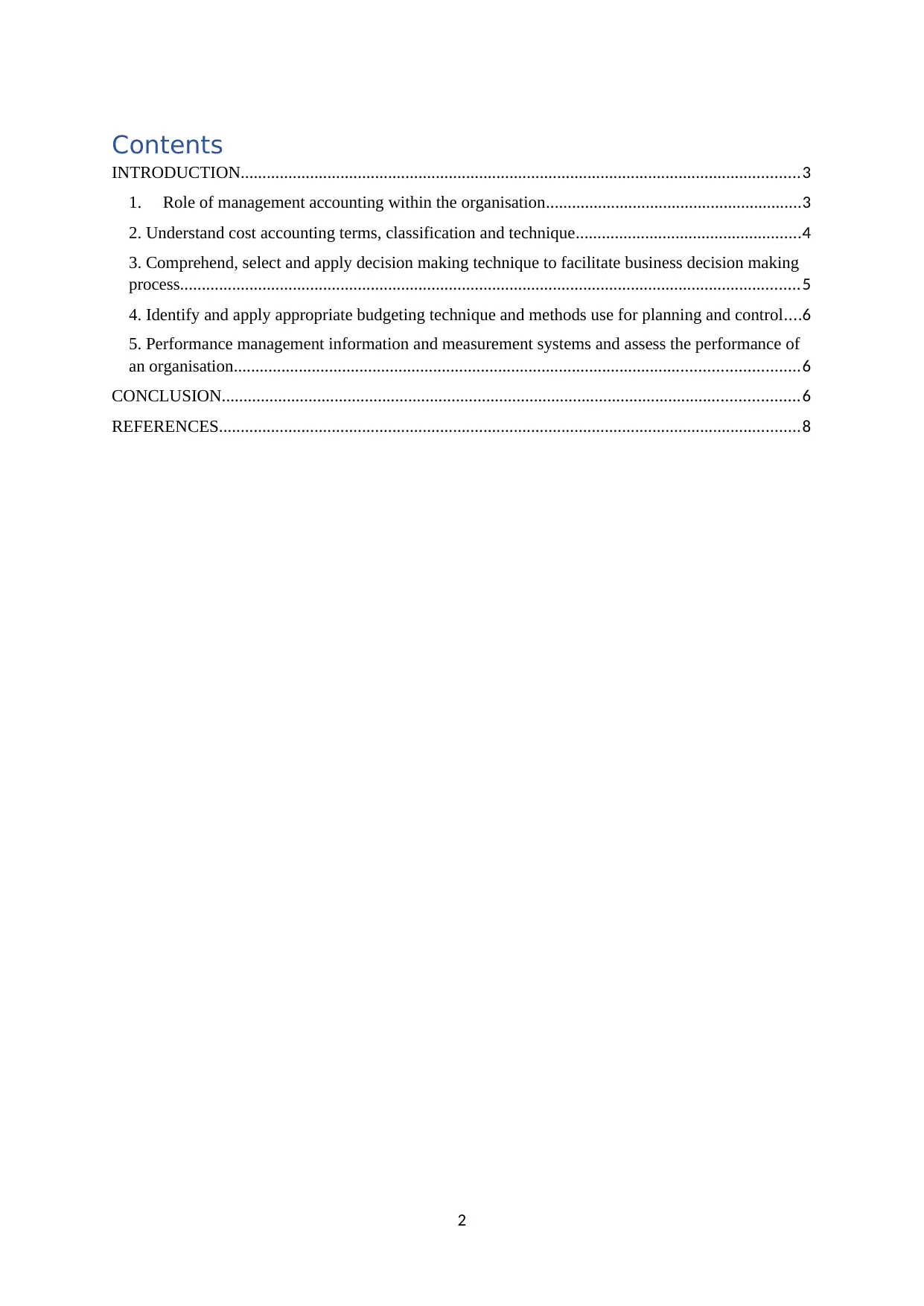
Contents
INTRODUCTION.................................................................................................................................3
1. Role of management accounting within the organisation...........................................................3
2. Understand cost accounting terms, classification and technique....................................................4
3. Comprehend, select and apply decision making technique to facilitate business decision making
process...............................................................................................................................................5
4. Identify and apply appropriate budgeting technique and methods use for planning and control....6
5. Performance management information and measurement systems and assess the performance of
an organisation..................................................................................................................................6
CONCLUSION.....................................................................................................................................6
REFERENCES......................................................................................................................................8
2
INTRODUCTION.................................................................................................................................3
1. Role of management accounting within the organisation...........................................................3
2. Understand cost accounting terms, classification and technique....................................................4
3. Comprehend, select and apply decision making technique to facilitate business decision making
process...............................................................................................................................................5
4. Identify and apply appropriate budgeting technique and methods use for planning and control....6
5. Performance management information and measurement systems and assess the performance of
an organisation..................................................................................................................................6
CONCLUSION.....................................................................................................................................6
REFERENCES......................................................................................................................................8
2

INTRODUCTION
Management accounting helps to manage organisation and departments in systematic manner.
Mostly management decisions and management operations are the part of management accounting
system. It is very useful for the organisations to implement and use management accounting system
within the organisation (DRURY, 2013). This report is prepared subject to define the role of
management accounting with in alpha ltd company. Appropriate techniques of costing and budgeting
are defined in this context which are used in decision making. Performance management information
and measurement system is also defined in this report.
1. Role of management accounting within the organisation
Managerial accounting helps the company in formulating effective financial strategies,
monitor expenses and maintains profit margins. The role of management accounting
influences all aspects of firm’s operation. It refers to the process of preparing
management accounts and reports that gives timely and accurate information and
statistics needed by manager to make short-term decisions and day to day activities.
Unlike financial accounting, that prepares report mainly at the end of accounting
or financial year, management accounting help managers to prepare annual report on
monthly, weekly or quarterly basis for the internal audience of the company including
chief executive office, different departments etc. These types of reports mainly show the
amount of available cash, accounts receivable and payable, sales generated, variance
analysis, outstanding debt and other related statistics. Many organization in order to
survive in the competitive environment, that is concerned with rapidly changing
technology and market demand, are using modern methods to continuously work on
enhancing their quality control and reducing the cost of their product so as to gain high
competitive advantage over their rivals. In this particular situation, companies like
APLHA are changing their traditional information system to management accounting.
The primary function of management accounting is to aid management through the
process of revenue and profit maximization. Following are the roles of management
accounting:
1. Formulate Financial Strategies: Management accounting assist in formulating financial
strategies using budget, sales forecast and job costing techniques (Granlund, 2011). They also
cake take into consideration data from company’s financial report to develop effective
strategies that leads to enhance their net profit, gross income and earnings per share.
2. Explain Financial Consequences of Decisions: With the help of management
accounting, manager can easily state the ramification of adding additional equity
financing or debt. Moreover, it also aid in explaining how decisions influence financial
statement and budget. For example: How decision made by company’s manager change
the overall profit and loss for the given period of time.
3. Monitor Expenses: With the management accounting, manager can create flexible,
static or rolling budget along with other essential report that help manager in monitor
overall expenses of the company throughout the year. It helps manager to run
organization in cost effective manner. In addition to that, with the help of management
accounting report it become much easier for stakeholder and other internal members to
understand the nature of the expenses related to each department in an effective manner.
Maintain Profitability: There are many management accounting tools that can be
taken into consideration while analysing the profitability of the firm or maintaining break-
3
Management accounting helps to manage organisation and departments in systematic manner.
Mostly management decisions and management operations are the part of management accounting
system. It is very useful for the organisations to implement and use management accounting system
within the organisation (DRURY, 2013). This report is prepared subject to define the role of
management accounting with in alpha ltd company. Appropriate techniques of costing and budgeting
are defined in this context which are used in decision making. Performance management information
and measurement system is also defined in this report.
1. Role of management accounting within the organisation
Managerial accounting helps the company in formulating effective financial strategies,
monitor expenses and maintains profit margins. The role of management accounting
influences all aspects of firm’s operation. It refers to the process of preparing
management accounts and reports that gives timely and accurate information and
statistics needed by manager to make short-term decisions and day to day activities.
Unlike financial accounting, that prepares report mainly at the end of accounting
or financial year, management accounting help managers to prepare annual report on
monthly, weekly or quarterly basis for the internal audience of the company including
chief executive office, different departments etc. These types of reports mainly show the
amount of available cash, accounts receivable and payable, sales generated, variance
analysis, outstanding debt and other related statistics. Many organization in order to
survive in the competitive environment, that is concerned with rapidly changing
technology and market demand, are using modern methods to continuously work on
enhancing their quality control and reducing the cost of their product so as to gain high
competitive advantage over their rivals. In this particular situation, companies like
APLHA are changing their traditional information system to management accounting.
The primary function of management accounting is to aid management through the
process of revenue and profit maximization. Following are the roles of management
accounting:
1. Formulate Financial Strategies: Management accounting assist in formulating financial
strategies using budget, sales forecast and job costing techniques (Granlund, 2011). They also
cake take into consideration data from company’s financial report to develop effective
strategies that leads to enhance their net profit, gross income and earnings per share.
2. Explain Financial Consequences of Decisions: With the help of management
accounting, manager can easily state the ramification of adding additional equity
financing or debt. Moreover, it also aid in explaining how decisions influence financial
statement and budget. For example: How decision made by company’s manager change
the overall profit and loss for the given period of time.
3. Monitor Expenses: With the management accounting, manager can create flexible,
static or rolling budget along with other essential report that help manager in monitor
overall expenses of the company throughout the year. It helps manager to run
organization in cost effective manner. In addition to that, with the help of management
accounting report it become much easier for stakeholder and other internal members to
understand the nature of the expenses related to each department in an effective manner.
Maintain Profitability: There are many management accounting tools that can be
taken into consideration while analysing the profitability of the firm or maintaining break-
3
⊘ This is a preview!⊘
Do you want full access?
Subscribe today to unlock all pages.

Trusted by 1+ million students worldwide
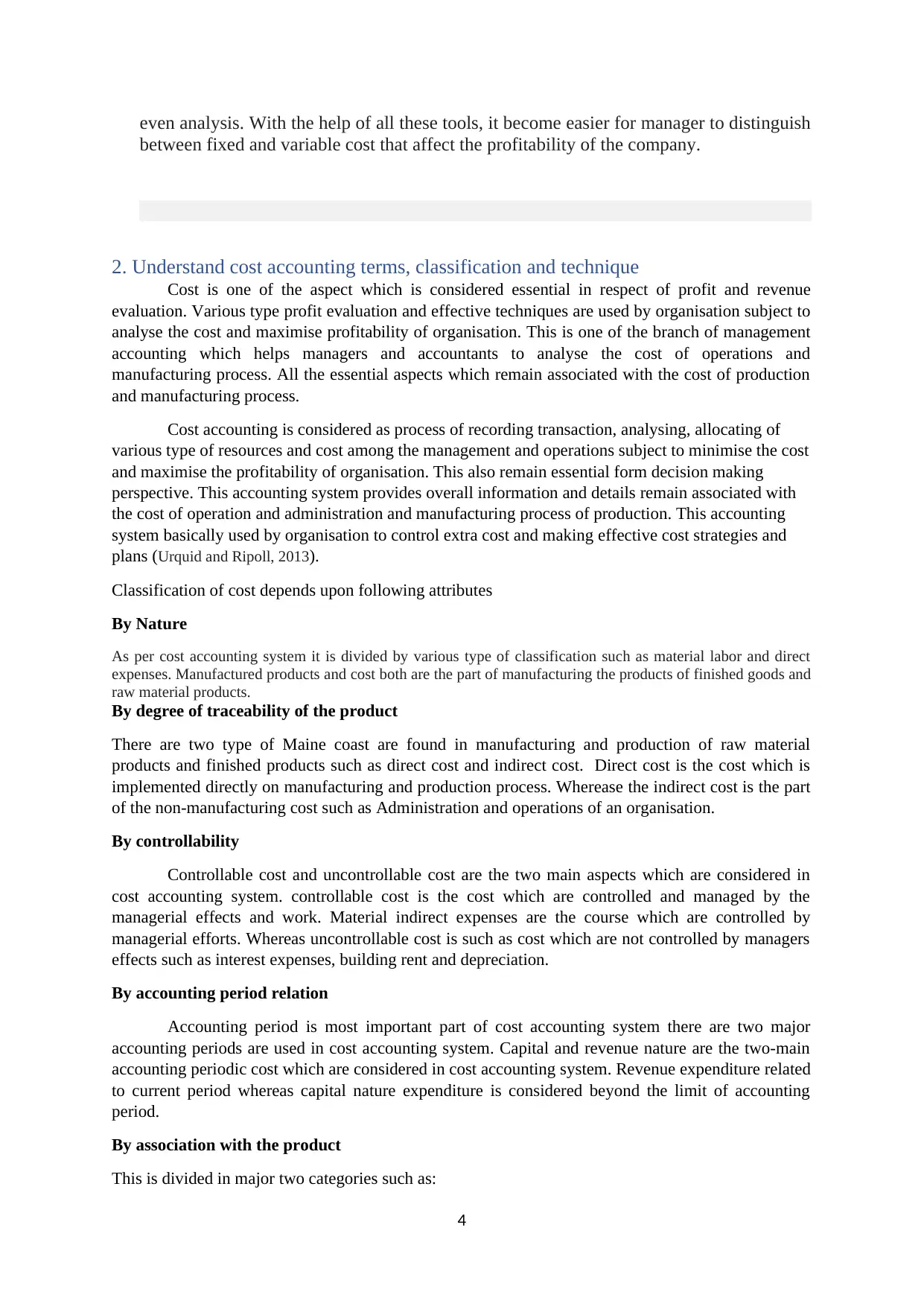
even analysis. With the help of all these tools, it become easier for manager to distinguish
between fixed and variable cost that affect the profitability of the company.
2. Understand cost accounting terms, classification and technique
Cost is one of the aspect which is considered essential in respect of profit and revenue
evaluation. Various type profit evaluation and effective techniques are used by organisation subject to
analyse the cost and maximise profitability of organisation. This is one of the branch of management
accounting which helps managers and accountants to analyse the cost of operations and
manufacturing process. All the essential aspects which remain associated with the cost of production
and manufacturing process.
Cost accounting is considered as process of recording transaction, analysing, allocating of
various type of resources and cost among the management and operations subject to minimise the cost
and maximise the profitability of organisation. This also remain essential form decision making
perspective. This accounting system provides overall information and details remain associated with
the cost of operation and administration and manufacturing process of production. This accounting
system basically used by organisation to control extra cost and making effective cost strategies and
plans (Urquid and Ripoll, 2013).
Classification of cost depends upon following attributes
By Nature
As per cost accounting system it is divided by various type of classification such as material labor and direct
expenses. Manufactured products and cost both are the part of manufacturing the products of finished goods and
raw material products.
By degree of traceability of the product
There are two type of Maine coast are found in manufacturing and production of raw material
products and finished products such as direct cost and indirect cost. Direct cost is the cost which is
implemented directly on manufacturing and production process. Wherease the indirect cost is the part
of the non-manufacturing cost such as Administration and operations of an organisation.
By controllability
Controllable cost and uncontrollable cost are the two main aspects which are considered in
cost accounting system. controllable cost is the cost which are controlled and managed by the
managerial effects and work. Material indirect expenses are the course which are controlled by
managerial efforts. Whereas uncontrollable cost is such as cost which are not controlled by managers
effects such as interest expenses, building rent and depreciation.
By accounting period relation
Accounting period is most important part of cost accounting system there are two major
accounting periods are used in cost accounting system. Capital and revenue nature are the two-main
accounting periodic cost which are considered in cost accounting system. Revenue expenditure related
to current period whereas capital nature expenditure is considered beyond the limit of accounting
period.
By association with the product
This is divided in major two categories such as:
4
between fixed and variable cost that affect the profitability of the company.
2. Understand cost accounting terms, classification and technique
Cost is one of the aspect which is considered essential in respect of profit and revenue
evaluation. Various type profit evaluation and effective techniques are used by organisation subject to
analyse the cost and maximise profitability of organisation. This is one of the branch of management
accounting which helps managers and accountants to analyse the cost of operations and
manufacturing process. All the essential aspects which remain associated with the cost of production
and manufacturing process.
Cost accounting is considered as process of recording transaction, analysing, allocating of
various type of resources and cost among the management and operations subject to minimise the cost
and maximise the profitability of organisation. This also remain essential form decision making
perspective. This accounting system provides overall information and details remain associated with
the cost of operation and administration and manufacturing process of production. This accounting
system basically used by organisation to control extra cost and making effective cost strategies and
plans (Urquid and Ripoll, 2013).
Classification of cost depends upon following attributes
By Nature
As per cost accounting system it is divided by various type of classification such as material labor and direct
expenses. Manufactured products and cost both are the part of manufacturing the products of finished goods and
raw material products.
By degree of traceability of the product
There are two type of Maine coast are found in manufacturing and production of raw material
products and finished products such as direct cost and indirect cost. Direct cost is the cost which is
implemented directly on manufacturing and production process. Wherease the indirect cost is the part
of the non-manufacturing cost such as Administration and operations of an organisation.
By controllability
Controllable cost and uncontrollable cost are the two main aspects which are considered in
cost accounting system. controllable cost is the cost which are controlled and managed by the
managerial effects and work. Material indirect expenses are the course which are controlled by
managerial efforts. Whereas uncontrollable cost is such as cost which are not controlled by managers
effects such as interest expenses, building rent and depreciation.
By accounting period relation
Accounting period is most important part of cost accounting system there are two major
accounting periods are used in cost accounting system. Capital and revenue nature are the two-main
accounting periodic cost which are considered in cost accounting system. Revenue expenditure related
to current period whereas capital nature expenditure is considered beyond the limit of accounting
period.
By association with the product
This is divided in major two categories such as:
4
Paraphrase This Document
Need a fresh take? Get an instant paraphrase of this document with our AI Paraphraser
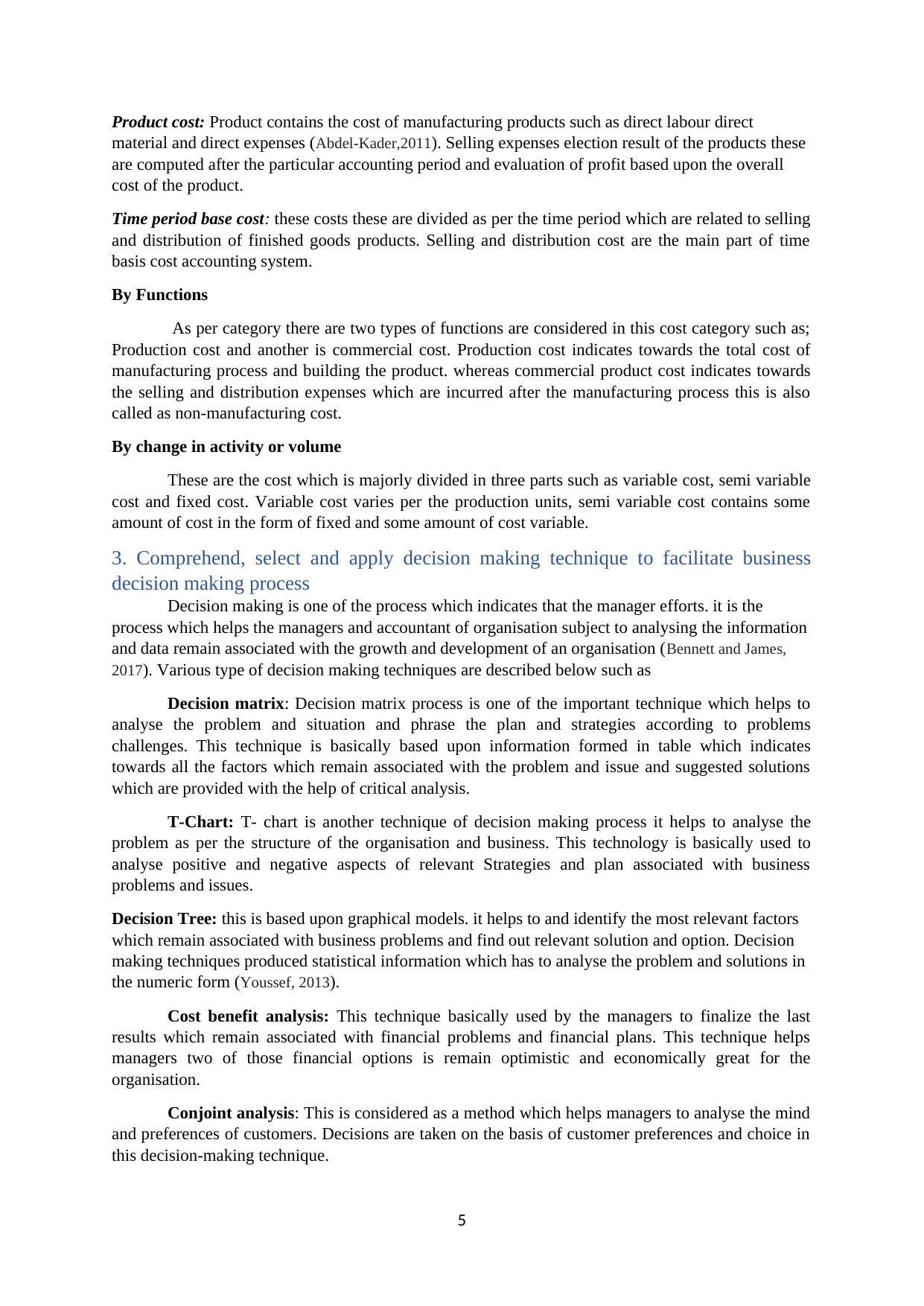
Product cost: Product contains the cost of manufacturing products such as direct labour direct
material and direct expenses (Abdel-Kader,2011). Selling expenses election result of the products these
are computed after the particular accounting period and evaluation of profit based upon the overall
cost of the product.
Time period base cost: these costs these are divided as per the time period which are related to selling
and distribution of finished goods products. Selling and distribution cost are the main part of time
basis cost accounting system.
By Functions
As per category there are two types of functions are considered in this cost category such as;
Production cost and another is commercial cost. Production cost indicates towards the total cost of
manufacturing process and building the product. whereas commercial product cost indicates towards
the selling and distribution expenses which are incurred after the manufacturing process this is also
called as non-manufacturing cost.
By change in activity or volume
These are the cost which is majorly divided in three parts such as variable cost, semi variable
cost and fixed cost. Variable cost varies per the production units, semi variable cost contains some
amount of cost in the form of fixed and some amount of cost variable.
3. Comprehend, select and apply decision making technique to facilitate business
decision making process
Decision making is one of the process which indicates that the manager efforts. it is the
process which helps the managers and accountant of organisation subject to analysing the information
and data remain associated with the growth and development of an organisation (Bennett and James,
2017). Various type of decision making techniques are described below such as
Decision matrix: Decision matrix process is one of the important technique which helps to
analyse the problem and situation and phrase the plan and strategies according to problems
challenges. This technique is basically based upon information formed in table which indicates
towards all the factors which remain associated with the problem and issue and suggested solutions
which are provided with the help of critical analysis.
T-Chart: T- chart is another technique of decision making process it helps to analyse the
problem as per the structure of the organisation and business. This technology is basically used to
analyse positive and negative aspects of relevant Strategies and plan associated with business
problems and issues.
Decision Tree: this is based upon graphical models. it helps to and identify the most relevant factors
which remain associated with business problems and find out relevant solution and option. Decision
making techniques produced statistical information which has to analyse the problem and solutions in
the numeric form (Youssef, 2013).
Cost benefit analysis: This technique basically used by the managers to finalize the last
results which remain associated with financial problems and financial plans. This technique helps
managers two of those financial options is remain optimistic and economically great for the
organisation.
Conjoint analysis: This is considered as a method which helps managers to analyse the mind
and preferences of customers. Decisions are taken on the basis of customer preferences and choice in
this decision-making technique.
5
material and direct expenses (Abdel-Kader,2011). Selling expenses election result of the products these
are computed after the particular accounting period and evaluation of profit based upon the overall
cost of the product.
Time period base cost: these costs these are divided as per the time period which are related to selling
and distribution of finished goods products. Selling and distribution cost are the main part of time
basis cost accounting system.
By Functions
As per category there are two types of functions are considered in this cost category such as;
Production cost and another is commercial cost. Production cost indicates towards the total cost of
manufacturing process and building the product. whereas commercial product cost indicates towards
the selling and distribution expenses which are incurred after the manufacturing process this is also
called as non-manufacturing cost.
By change in activity or volume
These are the cost which is majorly divided in three parts such as variable cost, semi variable
cost and fixed cost. Variable cost varies per the production units, semi variable cost contains some
amount of cost in the form of fixed and some amount of cost variable.
3. Comprehend, select and apply decision making technique to facilitate business
decision making process
Decision making is one of the process which indicates that the manager efforts. it is the
process which helps the managers and accountant of organisation subject to analysing the information
and data remain associated with the growth and development of an organisation (Bennett and James,
2017). Various type of decision making techniques are described below such as
Decision matrix: Decision matrix process is one of the important technique which helps to
analyse the problem and situation and phrase the plan and strategies according to problems
challenges. This technique is basically based upon information formed in table which indicates
towards all the factors which remain associated with the problem and issue and suggested solutions
which are provided with the help of critical analysis.
T-Chart: T- chart is another technique of decision making process it helps to analyse the
problem as per the structure of the organisation and business. This technology is basically used to
analyse positive and negative aspects of relevant Strategies and plan associated with business
problems and issues.
Decision Tree: this is based upon graphical models. it helps to and identify the most relevant factors
which remain associated with business problems and find out relevant solution and option. Decision
making techniques produced statistical information which has to analyse the problem and solutions in
the numeric form (Youssef, 2013).
Cost benefit analysis: This technique basically used by the managers to finalize the last
results which remain associated with financial problems and financial plans. This technique helps
managers two of those financial options is remain optimistic and economically great for the
organisation.
Conjoint analysis: This is considered as a method which helps managers to analyse the mind
and preferences of customers. Decisions are taken on the basis of customer preferences and choice in
this decision-making technique.
5

SWOT analysis: This is one of the common technique which is used by every type of organisation
whether it is small or large-scale business (Gullkvist, 2013). SWOT indicates towards strength
weakness opportunities and threats of organisation. This is one of the essential planning tool which is
used by managers to analyse the strength and weakness of organisation in comparison to their
competitors.
PEST analysis: This technique also used to analyse the external factors which affect the
organisations performance and Management. It indicates towards political, economic, social and
technical analysis.
4. Identify and apply appropriate budgeting technique and methods use for planning
and control
Budgets indicates towards forecasted information and plans for in order to attain perfectness
and accuracy with in operation and management. Budget indicates towards forecasted results and
information based upon past records and financial statements. Basically, budgets are prepared for
maximum period of one financial year (Budgetary control techniques, 2017). Various type of budgeting
techniques is used by organisation such as:
Variance analysis
Variance analysis is one of the budgeting technique which helps to analyse the actual results
and budgeted results. Positive balance is considered as favourable results and negative balance are
considered as unfavourable results.
Responsibility accounting
There are three major factors are defined in this technique this is one of the best techniques
which is considered as effective for organisation. This technique classifies the cost in 3 major parts
purchase cost Centre profit centre and investment centre.
Adjustment of funds
This technique works around how the function be managed in optimistic manner so that possible
outcomes could be achieved by the organisation (Cardoni, 2012). This budgeting technique helps to
allocate the funds as per required areas. Allocation of funds and appropriation of reserves and funds
remain depends upon the requirement and necessity of projects.
Zero based budgeting
This technique is one of the common technique of budgeting. There is a brief analysis and
study done in Zero Based budgeting technique. This helps to analyse the aspects from grass root level.
Every year budgets are prepared by the managers on the basis of nil balance there is no any relevant
details and information are taken from past records.
5. Performance management information and measurement systems and assess the
performance of an organisation
Performance management is one of the main aspect of business and organisations. For every
organisation it is required that organisation work smooth and fluently without any problem and
circulations (Wall and Greiling, 2011). Performance information and measurement system helps to track
the performance of every individual and group of people in organisation. There is an individual
performance is recorded in this system and statistical results and information presented in graphical
structure. This syetem is also beneficial subject to identify best performer and potential employees in
organisation.
6
whether it is small or large-scale business (Gullkvist, 2013). SWOT indicates towards strength
weakness opportunities and threats of organisation. This is one of the essential planning tool which is
used by managers to analyse the strength and weakness of organisation in comparison to their
competitors.
PEST analysis: This technique also used to analyse the external factors which affect the
organisations performance and Management. It indicates towards political, economic, social and
technical analysis.
4. Identify and apply appropriate budgeting technique and methods use for planning
and control
Budgets indicates towards forecasted information and plans for in order to attain perfectness
and accuracy with in operation and management. Budget indicates towards forecasted results and
information based upon past records and financial statements. Basically, budgets are prepared for
maximum period of one financial year (Budgetary control techniques, 2017). Various type of budgeting
techniques is used by organisation such as:
Variance analysis
Variance analysis is one of the budgeting technique which helps to analyse the actual results
and budgeted results. Positive balance is considered as favourable results and negative balance are
considered as unfavourable results.
Responsibility accounting
There are three major factors are defined in this technique this is one of the best techniques
which is considered as effective for organisation. This technique classifies the cost in 3 major parts
purchase cost Centre profit centre and investment centre.
Adjustment of funds
This technique works around how the function be managed in optimistic manner so that possible
outcomes could be achieved by the organisation (Cardoni, 2012). This budgeting technique helps to
allocate the funds as per required areas. Allocation of funds and appropriation of reserves and funds
remain depends upon the requirement and necessity of projects.
Zero based budgeting
This technique is one of the common technique of budgeting. There is a brief analysis and
study done in Zero Based budgeting technique. This helps to analyse the aspects from grass root level.
Every year budgets are prepared by the managers on the basis of nil balance there is no any relevant
details and information are taken from past records.
5. Performance management information and measurement systems and assess the
performance of an organisation
Performance management is one of the main aspect of business and organisations. For every
organisation it is required that organisation work smooth and fluently without any problem and
circulations (Wall and Greiling, 2011). Performance information and measurement system helps to track
the performance of every individual and group of people in organisation. There is an individual
performance is recorded in this system and statistical results and information presented in graphical
structure. This syetem is also beneficial subject to identify best performer and potential employees in
organisation.
6
⊘ This is a preview!⊘
Do you want full access?
Subscribe today to unlock all pages.

Trusted by 1+ million students worldwide

CONCLUSION
This report is prepared to define management accounting techniques use of decision making
and controlling the cost of operation and management. Various type of cost is defined and classified
in this context. Decision making techniques and tools are defined which are used in decision making
process of an organisation. Appropriate budgeting technique and methods are defined used for
planning and control. Performance management information system is defined subject to alpha ltd
organisation.
7
This report is prepared to define management accounting techniques use of decision making
and controlling the cost of operation and management. Various type of cost is defined and classified
in this context. Decision making techniques and tools are defined which are used in decision making
process of an organisation. Appropriate budgeting technique and methods are defined used for
planning and control. Performance management information system is defined subject to alpha ltd
organisation.
7
Paraphrase This Document
Need a fresh take? Get an instant paraphrase of this document with our AI Paraphraser
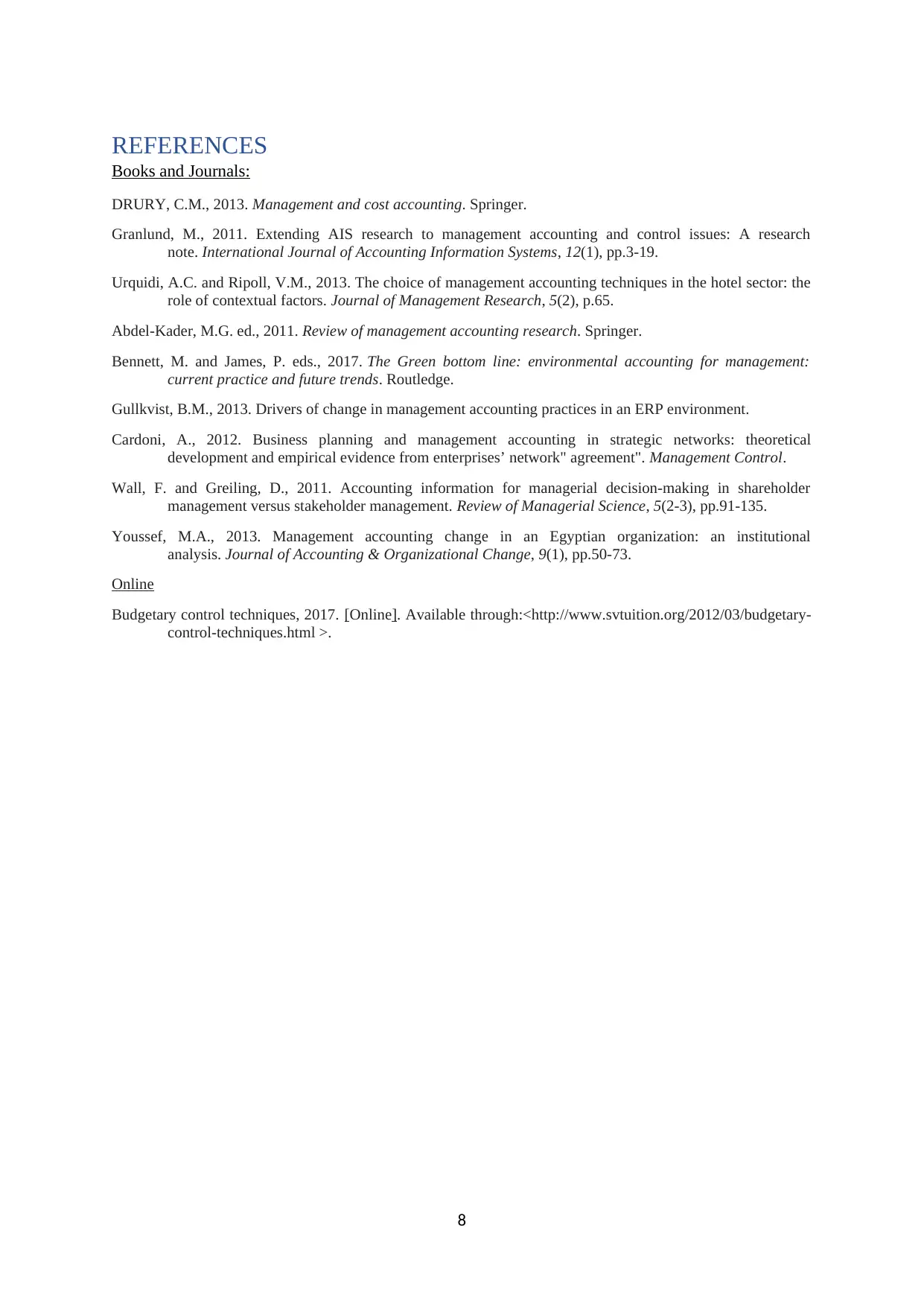
REFERENCES
Books and Journals:
DRURY, C.M., 2013. Management and cost accounting. Springer.
Granlund, M., 2011. Extending AIS research to management accounting and control issues: A research
note. International Journal of Accounting Information Systems, 12(1), pp.3-19.
Urquidi, A.C. and Ripoll, V.M., 2013. The choice of management accounting techniques in the hotel sector: the
role of contextual factors. Journal of Management Research, 5(2), p.65.
Abdel-Kader, M.G. ed., 2011. Review of management accounting research. Springer.
Bennett, M. and James, P. eds., 2017. The Green bottom line: environmental accounting for management:
current practice and future trends. Routledge.
Gullkvist, B.M., 2013. Drivers of change in management accounting practices in an ERP environment.
Cardoni, A., 2012. Business planning and management accounting in strategic networks: theoretical
development and empirical evidence from enterprises’ network" agreement". Management Control.
Wall, F. and Greiling, D., 2011. Accounting information for managerial decision-making in shareholder
management versus stakeholder management. Review of Managerial Science, 5(2-3), pp.91-135.
Youssef, M.A., 2013. Management accounting change in an Egyptian organization: an institutional
analysis. Journal of Accounting & Organizational Change, 9(1), pp.50-73.
Online
Budgetary control techniques, 2017. [Online]. Available through:<http://www.svtuition.org/2012/03/budgetary-
control-techniques.html >.
8
Books and Journals:
DRURY, C.M., 2013. Management and cost accounting. Springer.
Granlund, M., 2011. Extending AIS research to management accounting and control issues: A research
note. International Journal of Accounting Information Systems, 12(1), pp.3-19.
Urquidi, A.C. and Ripoll, V.M., 2013. The choice of management accounting techniques in the hotel sector: the
role of contextual factors. Journal of Management Research, 5(2), p.65.
Abdel-Kader, M.G. ed., 2011. Review of management accounting research. Springer.
Bennett, M. and James, P. eds., 2017. The Green bottom line: environmental accounting for management:
current practice and future trends. Routledge.
Gullkvist, B.M., 2013. Drivers of change in management accounting practices in an ERP environment.
Cardoni, A., 2012. Business planning and management accounting in strategic networks: theoretical
development and empirical evidence from enterprises’ network" agreement". Management Control.
Wall, F. and Greiling, D., 2011. Accounting information for managerial decision-making in shareholder
management versus stakeholder management. Review of Managerial Science, 5(2-3), pp.91-135.
Youssef, M.A., 2013. Management accounting change in an Egyptian organization: an institutional
analysis. Journal of Accounting & Organizational Change, 9(1), pp.50-73.
Online
Budgetary control techniques, 2017. [Online]. Available through:<http://www.svtuition.org/2012/03/budgetary-
control-techniques.html >.
8
1 out of 8
Related Documents
Your All-in-One AI-Powered Toolkit for Academic Success.
+13062052269
info@desklib.com
Available 24*7 on WhatsApp / Email
![[object Object]](/_next/static/media/star-bottom.7253800d.svg)
Unlock your academic potential
Copyright © 2020–2025 A2Z Services. All Rights Reserved. Developed and managed by ZUCOL.





